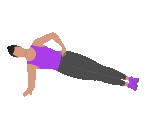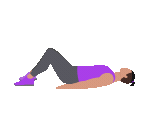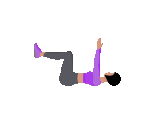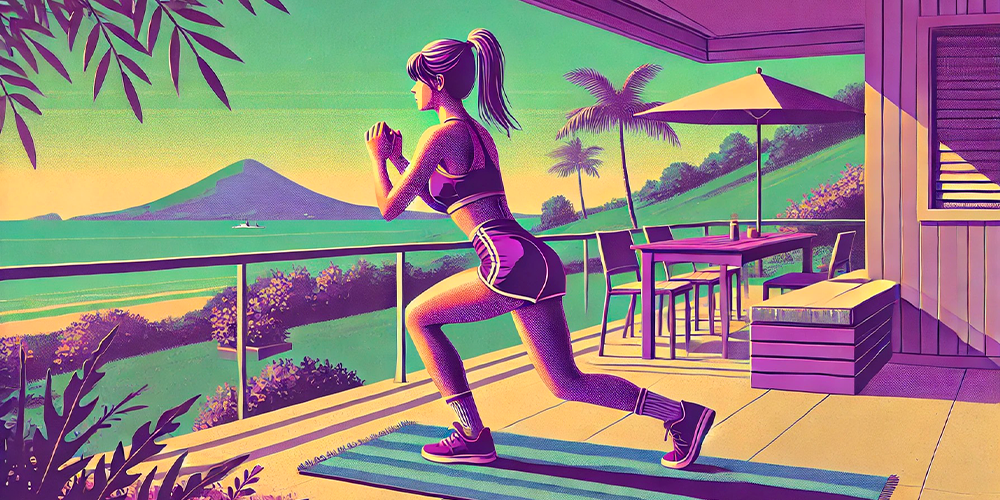No gym needed, no equipment required. Even on vacation, you can keep your muscles active with a simple bodyweight workout. It only takes 20 minutes, twice a week. Perfect for staying fit… without sacrificing relaxation.
Little, but done well
Endurance athletes know: a complete stop in training is not that simple, especially when a race is approaching. The body is used to moving, and even on vacation, a bit of activity feels good – both physically and mentally.
6 Tips for Training During Vacation
In the summer, it’s not about aiming for peak performance or increasing weights. The goal is to maintain what you’ve built over the past months, without overdoing it or completely stopping.
With a simple 20-minute bodyweight workout, repeated twice a week, you can keep your muscles active even on vacation, without stressing yourself out. No equipment or gym necessary. All you need is a quiet place, a mat… and some motivation!
Why It’s Helpful to Work on Strength Even in Summer
Summer is the perfect time to slow down, take a break, and recharge your batteries. And that’s perfectly fine. But if you want to stay at least somewhat active without disrupting your free time, a little bodyweight training can make all the difference: just a few minutes are enough to keep your muscles awake and prepare your body for a potential race.
Even a few bodyweight sessions allow you to:
- Keep stabilizing muscles active, which are essential for protecting joints and posture during long rides or climbs.
- Reduce the risk of pain and injury, especially in the back, hips, and shoulders, when increasing volume without compensating with strength training.
- Support efficiency in endurance sports like cycling, running, or swimming by improving movement economy and motor control.
Plus, summer strength training is naturally flexible: no complicated equipment or gym required (although it’s a definite advantage if your hotel offers one), and it adapts easily to vacation schedules and contexts.
You can train outdoors, early in the morning or at sunset, on a terrace, in a garden, while camping, or by the lake. You don’t need much: a mat, a towel, and twenty minutes will do. And if a refreshing swim comes after the session… even better: active recovery confirmed.
Bodyweight Strength Training Routine
Duration: about 20 minutes
Recommended Frequency: 2 times per week
Structure: 2 rounds per circuit
Rest between exercises: 30-45 seconds
Circuit 1 – Full Activation
Legs and Glutes
- Bodyweight Squats – 15 reps
Quadriceps, glutes, hamstrings - Alternating Lunges – 12 per leg
Glutes, hamstrings, balance
Core (Abs and Lower Back)
- Plank – 30 to 60 seconds
Deep abdominals, posture - Side Plank right/left – 30 seconds each side
Obliques, hips, lateral stability

UPPER BODY AND BACK
- Bridge (Hip Raise) – 15 reps
Glutes, hamstrings, lower back

- Push-ups – 10 to 15 reps
Chest, shoulders, triceps, core
Circuit 2 – Variation for the second day
LEGS AND GLUTES
- Jump Squats (explosive) – 10 reps
Power, reactivity - Wall Sit – 30 to 60 seconds
Static strength of the quadriceps and core
CORE
- Mountain Climbers – 20 to 30 seconds
Abs, cardio, scapular stabilization - Dead Bug – 10 each side
Deep core, lumbar control

UPPER BODY AND BACK
- Row with resistance band or towel – 15 reps
Back, biceps, shoulders - Close Push-ups (triceps) – 8 to 12 reps
Arms and abs
Conclusion: Vacation yes, but the body doesn’t stop
Summer is the perfect time to slow down, change the pace, and recharge mentally. That’s totally normal. But slowing down doesn’t mean stopping everything, especially when you’re used to moving and feeling good in your body.
With just two bodyweight sessions per week, you can maintain basic muscle activation, preserve your postural stability, and keep the body-mind connection alive – without overloading your vacation routine. And if you want variety, there are a thousand ways to stay active even away from home: a short 30-minute run in the morning before everyone wakes up, an exploratory bike ride, a hike in the mountains, or a refreshing swim in the lake or sea. The important thing is to keep moving – without pressure, but with awareness.
